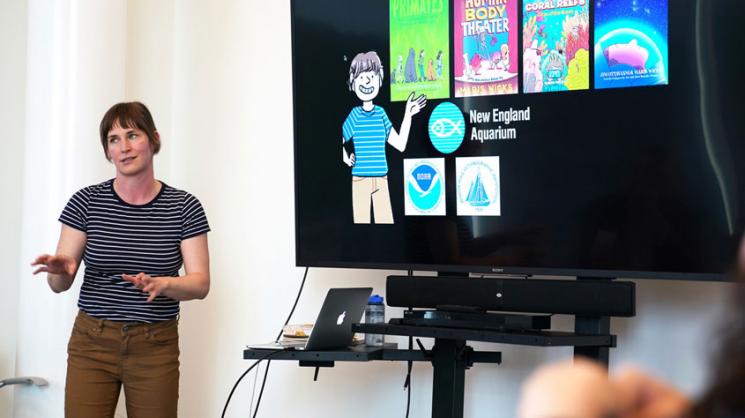“I’m not a scientist and I’m not an engineer. Science is what I love and comics is how I think.”
For Maris Wicks, there’s no contradiction between comic books and the seemingly rarified worlds of science and engineering. She has published comics devoted to primate research, coral reefs and the human body, and is working on a new one about female astronauts. Wicks has worked for the New England Aquarium and received an NSF grant to spend two and a half months with scientists in Antarctica in 2016-17 (which she’s turning into another book).
“I’m a science nerd. I’m writing and drawing for the general public. When I do that, I have to learn a lot and turn it around for them. It’s like translation,” said Wicks, a Boston-based artist who, on Feb. 15, held two workshops at Rice University called Comics x Science (Using Cartoons to Communicate Complex Ideas).
Some 30 students, most of them bioengineering (BIOE) undergraduates, attended the workshops held in the Moody Center for the Arts. Jane Grande-Allen, the Isabel C. Cameron Professor of BIOE and chair of the BIOE department, said:
“The ability to communicate challenging academic concepts in a way that anyone can understand is essential for the public understanding of the work we do at Rice. It also makes the inventors of these concepts articulate their key ideas. In doing so they come to understand those ideas better. Comics are an appealing way to go about this.”
Wicks showed slides illustrating the history of comics and cartooning, beginning with cave paintings from the Upper Paleolithic and culminating with Winsor McCay, Charles Schulz and super-hero comics. She had the students draw faces to suggest a variety of emotions and a series of panels illustrating a simple narrative.
“Creativity is not a talent. It’s an inherent human trait. We wouldn’t be where we are as a species without it,” Wicks said.
“Visual representations are very different from words. They’re more direct and understood by more people,” said William Wan, a sophomore in BIOE. In China, Wan grew up reading manga (popular comics originating in Japan that are read by children and adults) from his country and Japan.
“I enjoy drawing comics too. It’s a relief from the work in bioengineering. I find that it helps when we’re making posters, which tend to be sort of messy and confused. The aesthetic part is important,” said Wan, who is taking a class with Christopher Sperandio, associate professor of visual and dramatics arts at Rice.
“I think the drive toward specialization has reached a sort of crescendo. I think students are ready to be exposed to both the STEM field and the arts,” said Sperandio, who teaches courses at Rice in drawing and in visual and sequential art.
Until recently, Aurelia Vick majored in computer science but has switched to visual and dramatic arts. “I like that Maris stressed that we shouldn’t be afraid of simplicity or look down on it,” she said. “I think the most effective way to communicate it to do it simply.”
“Creativity is the backbone of being a human being,” Wicks said.
Her visit was funded by a grant from the Arts Initiative Program at Rice.

